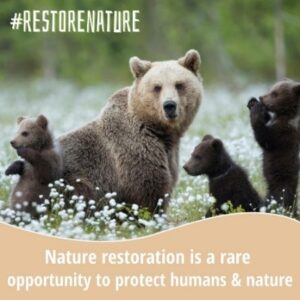Restoring nature will secure our future – winds of change must set us on the right path
Nature is all around us – giving and sustaining life. But we must ensure that we see the forest for the trees. The impassioned debate that enveloped the EU’s Nature Restoration Law earlier this month demonstrated the importance of taking a breath and stepping back from the business of our daily routines. We must remember that we owe much to nature. Policymakers and regulators all over the world have a duty to protect it.

Nature restoration is a long-term investment we can make for our survival and that of other species. Protecting and restoring ecosystems has many invaluable benefits: securing stable food supply, increasing climate resilience, regulating carbon dioxide levels with plants and healthy oceans, improving environmental health and therefore human health, and creating habitats for species.
What is the role of policy in restoring nature?
The adoption of the Global Biodiversity Framework (GBF) by the United Nations Convention on Biological Diversity in December 2022 was a major step towards creating new global momentum for action, setting goals and targets towards 2050.
Meanwhile, in the European Union, the adoption of the Nature Restoration Law by the European Parliament in July 2023 was a significant step in the right direction. However, unfortunately, the proposal’s key measures for restoring biodiversity impacted by human activities – such as farming, fishing, and forestry – were also stripped away from the original proposal by MEPs who opposed the law.
The Nature Restoration Law proposal had initially been hailed by NGOs and scientists as a key element of the EU Green Deal for restoring biodiversity. The current state of the law is therefore very concerning as it presents a very large gap in the level of ambition. You can read here NGOs’ #RestoreNature joint statement, issued in March 2023, as well as a paper signed by 6,000 scientists ahead of the recent vote, providing the evidence to support an ambitious Nature Restoration Law and debunk the myths of its detractors.
What comes next for nature in the EU?
In Europe, there is a pressing need to bring back nature into production systems, rather than separating natural spaces from managed land. Society has too long considered nature as a resource to exploit without harnessing the potential benefits of regenerative practices. Land use has been divided among productive areas (farmland, forest plantations), urban areas, and protected areas. While protecting land is a key measure for restoring it, the European Commission proposes that more should be done to ensure that nature recovers on a large scale. Evidence shows that although 25.7% of EU land and 11.1% of marine areas are protected, 81% of all habitats in the EU are in a poor ecological state.
Farmland represents 38% of the total land area of the EU. The Commission asserts that larger adoption of ecological farming practices could significantly improve impact over a huge proportion of EU territory. For instance, inclusion of biodiversity features on or near agricultural fields such as unmanaged parcels, hedges, and trees, could protect the soil from erosion, reduce eutrophication, store carbon dioxide in long-standing vegetation, and create a better microclimate for crops.
 The Nature Restoration Law is now going into trilogue negotiations, during which the proposal will be discussed by the European Commission, Parliament, and Council. ECOS calls upon EU co-legislators to restore the law’s key measures. We must not give in to fearmongering around food security: restoring agricultural lands, including peatlands, is key. Important habitats, including forests and marine areas, must be managed with clear ecological recovery objectives. These should include the creation of new protected areas, but also less impactful forestry and fishing practices.
The Nature Restoration Law is now going into trilogue negotiations, during which the proposal will be discussed by the European Commission, Parliament, and Council. ECOS calls upon EU co-legislators to restore the law’s key measures. We must not give in to fearmongering around food security: restoring agricultural lands, including peatlands, is key. Important habitats, including forests and marine areas, must be managed with clear ecological recovery objectives. These should include the creation of new protected areas, but also less impactful forestry and fishing practices.
How international standards can help to shift the global conversation
Standards can guide the action of private and public organisations towards taking better care of ecosystems and biodiversity. The work of ISO TC/331 Biodiversity will be key in providing best practice and implementable standards for biodiversity monitoring, organisational strategies to improve dependencies and impacts on nature, and creating regenerative food systems.
ECOS also sees a role for effective biodiversity reporting frameworks thanks to standards and to laws such as the Corporate Sustainability Reporting Directive. In April 2023, ECOS and Biodiversify published a report on meeting the Global Biodiversity Framework’s Target 15, which underlined the importance of these frameworks.
The conclusion for global policy and standards frameworks is clear: the triple crises of climate change, pollution, and biodiversity loss are real and we can only address them if we make nature our ally.

 By
By 
